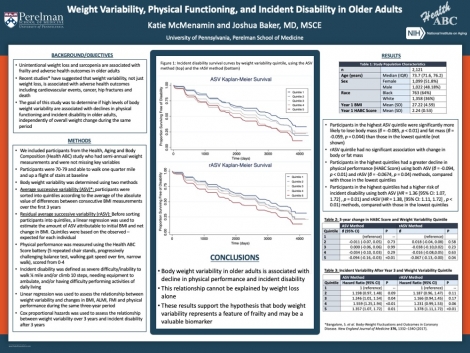Katie McMenamin
Weight Variability, Physical Functioning, and Incident Disability in Older Adults

Presenter

I am a second-year medical student at the Perelman School of Medicine and conducted this research with Dr. Baker through the support of the CCEB Summer Research Fellowship.
Abstract
The goal of this study was to determine if high levels of body weight variability are associated with declines in physical functioning and incident disability in older adults. We defined weight variability as the average successive variability of semiannual BMI measurements during the first 3 years of the Health, Aging and Body Composition study, and categorized participants into quintiles from lowest to highest variability. Outcomes included change in Health ABC Score (a physical performance battery) and time to incident disability. Linear regression was used to assess the relationship between weight variability and changes in BMI, ALMI, FMI and physical performance during the first three years of the study, while Cox proportional hazards models assessed the relationship between weight variability and subsequent time to incident disability, adjusting for confounding factors. Participants in the highest quintile of BMI variability were significantly more likely to lose both body mass (β = -0.085, p < 0.01) and fat mass (β = -0.059, p = 0.044) and had a greater decline in HABC Score (β = -0.094, p < 0.01) compared to participants with the least variability over three years. Participants in the highest quintile also had a higher risk of incident disability (HR = 1.36 [95% CI: 1.07, 1.72]), p = 0.01). Our results support the hypothesis that body weight variability in older adults is associated decline in physical performance and incident disability, and may be a useful biomarker for sarcopenia.
Keywords
body weight variability, frailty, sarcopenia, disabilityCommenting is now closed.
About Us
To understand health and disease today, we need new thinking and novel science —the kind we create when multiple disciplines work together from the ground up. That is why this department has put forward a bold vision in population-health science: a single academic home for biostatistics, epidemiology and informatics.
© 2023 Trustees of the University of Pennsylvania. All rights reserved.. | Disclaimer

